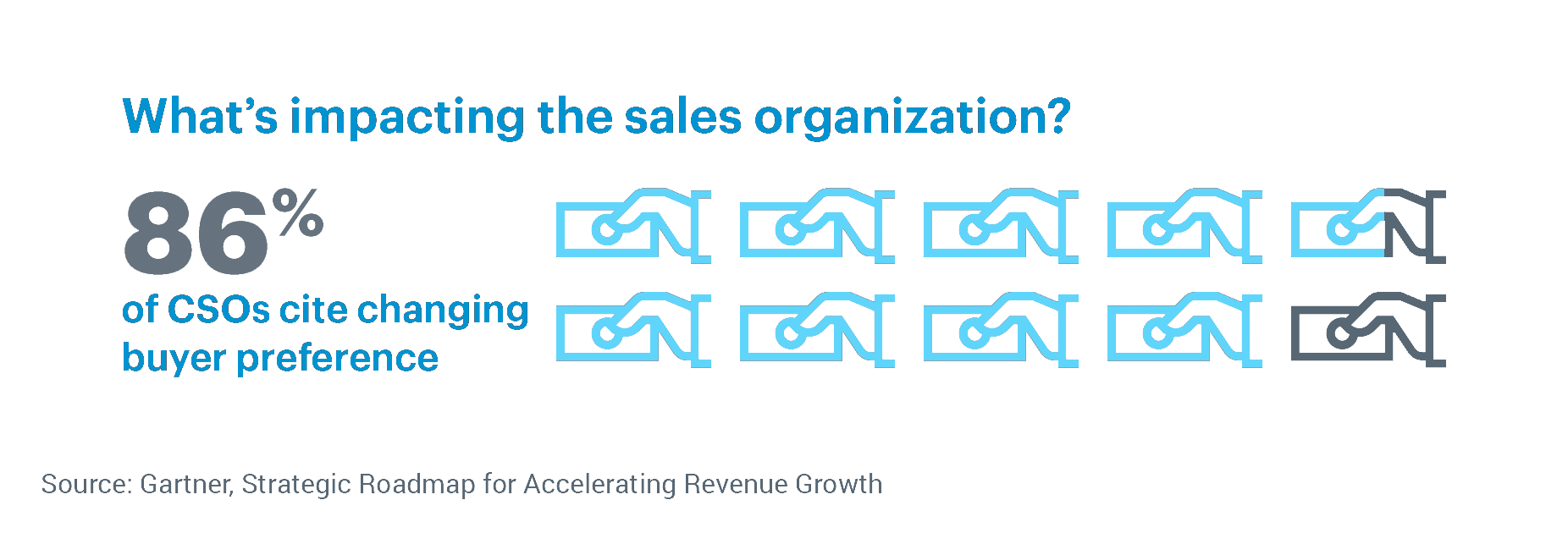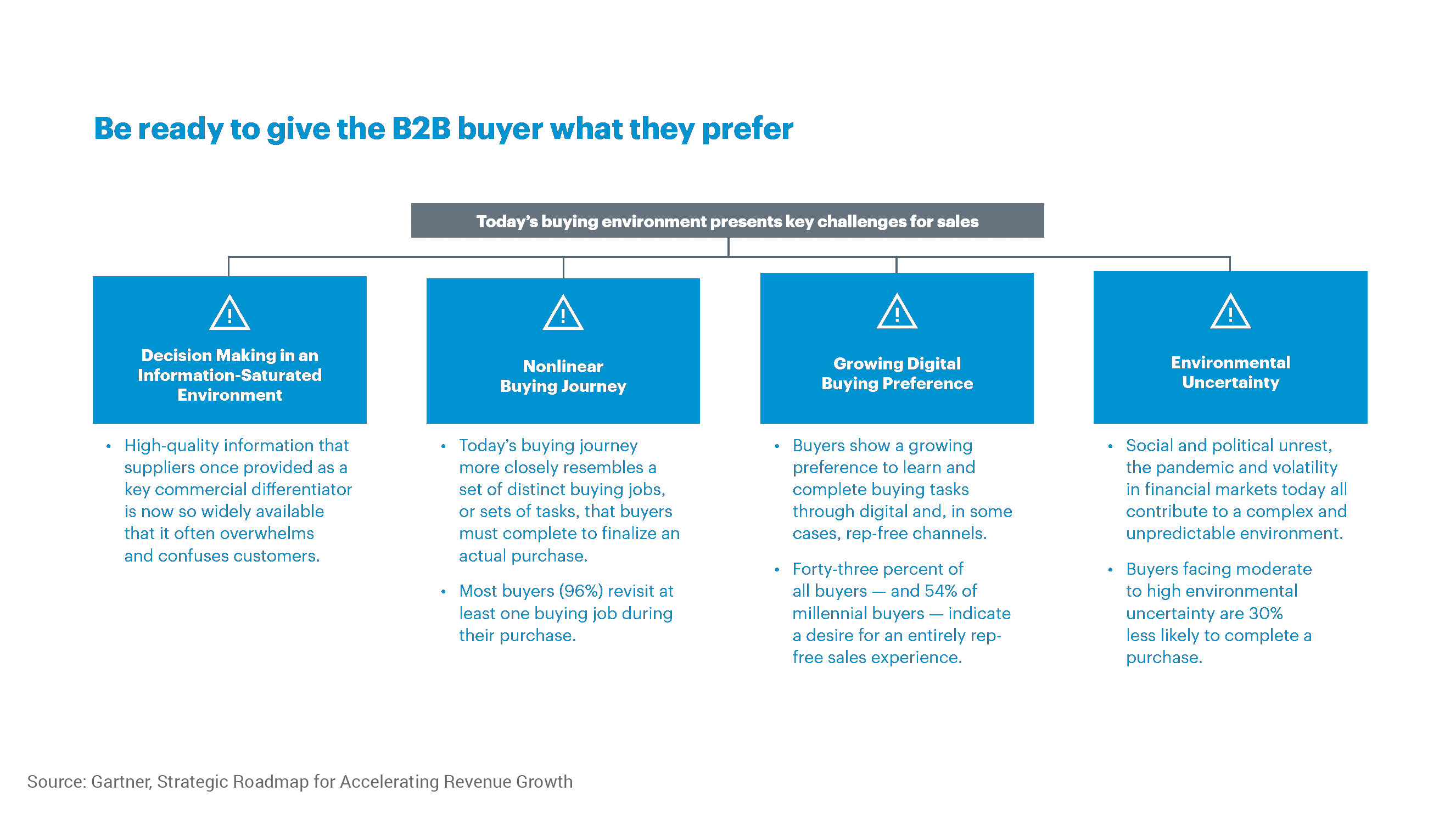B2B sales teams are feeling the pinch. The pandemic altered buyers’ plans and disrupted what was already a complex buyer’s journey.
Only 6% of sales officers say they are extremely confident about their team’s ability to meet or exceed revenue goals.
But why should the troubles of sales teams matter to marketers? And the answer is not just that the struggles of one group will always impact another. In most organizations, marketing supports sales and is responsible for generating more and better-qualified leads.
The disrupted B2B buyer environment
We looked at Gartner’s Strategic Roadmap for Accelerated Revenue Growth and the information we found was spot on. In the report, the research and advisory giant paints an accurate picture of the current B2B sales and marketing environment.

Changing buyer preferences are making it more difficult for sales teams to reach and convert potential buyers. Marketers are seeing this on the lead generation end as well.
Many of the channels, tactics, and messaging that teams found successful in the past aren’t resonating as strongly now. Four key challenges emerge as reasons why.

Making decisions in an information-saturated environment
The digital marketplace is saturated with content. Seventy-nine percent of B2B marketers have a documented content strategy, which means they’re churning out content on a regular basis. And that’s not counting those who create content without a documented strategy.
Content creation is listed as the top area marketers planned to invest in during 2021 (CMI, 2020).
Franky, buyers are overwhelmed and confused. They don’t need more content; they need better content.
B2B marketers need to focus on creating sales-support content that directly addresses buyers’ questions and concerns. Answer these three important questions (Medium, 2019) when developing your content marketing strategy:
- Is our content simplifying complex purchase decisions?
- Is our content shortening the buying process?
- Is our content making it easier for our buyers to buy?
If the answer to any of them is “no,” you might be oversaturating the environment with content that isn’t helpful.
Non-linear buyer’s journey
We’ve been preaching this for years. The path your buyers take isn’t straight. It’s more like a winding, twisting maze.
This is proven by the fact that 96% of buyers revisit at least one buying [step] during their purchase (Gartner, 2021).
Decision-makers are spending more time doing research on their own and, in some cases, it’s leading to longer purchase cycles. Marketing and sales teams need to actively engage prospects throughout their journey to keep them moving.
It’s never been more important to understand your buyer’s journey and the information they need along the way.

Our three-part series dives deeper into creating a buyer’s journey and using it to elevate your marketing.
Growing digital buying preference
Not only has your buyer’s journey become more complex, but they’d rather sales reps stay out of it.
Forty-three percent of all buyers indicate a desire for an entirely rep-free sales experience (Gartner, 2021).
That means sales reps shouldn’t bombard prospects with emails and requests for meetings. Instead, they should assist marketing behind the scenes until buyers are ready to engage.
Using insights derived from marketing analytics and your CRM, sales and marketing must team up to digitally nurture prospects. This can be done through email, social media, webinars, paid media, and blog articles.
Research the digital channels and content types your buyers respond to, distribute content on those channels, monitor where they are along their journey, and reach out when the time is right.
Environmental uncertainty
Throughout the pandemic, the word marketers and sales teams repeatedly heard was “empathy.” Given economic struggles, political unrest, and general uncertainty, customers needed it. Everyone needed it, really.
In response to the pandemic, 70% of B2B marketers changed their messaging strategy (CMI, 2020).
Marketers and sales teams will continue to benefit from empathetic messaging into 2022. They’ll also need to be nimble and open to rapid messaging changes like we saw throughout the last few years.
The pandemic isn’t over, and the political environment is just as divisive as ever. Keep that in mind when communicating with buyers. Their worlds aren’t completely right-side-up yet.
Additionally, teams are scattered due to remote and hybrid work and organizations are struggling to retain and attract talent. There is so much on the minds of buyers and so many complexities at play.
No wonder chief sales officers are feeling less than confident. The world has changed—and so too must our strategies for revenue growth.
Get a head start on your sales + marketing plans for 2022
We can help you build a marketing strategy that supports sales and drives revenue.
Reach out to our team or follow our 4-step process for developing your own 2022 strategy.
